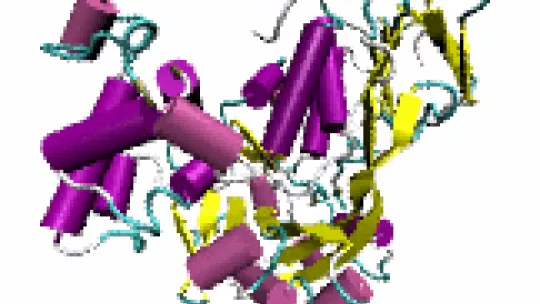Images
The machinery of life depends on proteins. These molecules perform vital roles in the organism: they contribute to maintaining cell structure; they are responsible for mechanical cellular tasks; they are decisive for internal and external communication by the cell; they regulate gene expression; they are key elements of the immune system; and they catalyze the reactions that take place in the organism. Proteins are organic molecules comprising tens, hundreds and even thousands of amino acids organized into long chains, which fold on themselves to form specific structures. For decades, scientists have known that in general the sequence of amino acids that comprises a protein determines its structure and function. However, exactly how the sequence translates into a physical structure remains unknown.
Understanding the mechanisms by which proteins are made, how and why they fold in a specific manner, how they act and interact, and finally improving our knowledge of how proteins work are the most exciting challenges faced in biomedical research. Indeed, biocomputation, with supercomputers as key tools, is allowing scientists to respond to many unanswered questions about these crucial agents for life.
Protein flexibility and molecular dynamics techniques
In recent years, scientists have discovered that the function of a protein is determined both by the stability of its structure and by conformational changes in response to external stimuli. This is what is known as the molecular flexibility of the protein. Thus, data on how and why proteins change their conformation and react to alterations in their milieu is crucial to improve our understanding about how biomolecules work.
Describing this flexibility experimentally is a complex task that requires computer modelling techniques. Modelling allows bioinformaticists to track the movements of all atoms in a protein over time. Molecular dynamics (MD) is the most efficient simulation technique available and one of the areas of study that uses the highest degree of the world’s supercomputing resources.
The team headed by Modesto Orozco, researcher at IRB Barcelona, Principal Investigator of the Bioinformatics and Molecular Modelling Group, and Director of the Computational Biology Programme at the Barcelona Supercomputing Center, is developing an extensive “library” of 1,900 proteins in motion with the aid of the MareNostrum supercomputer. The database, called MoDel, will allow users to observe how 3D structures of representative proteins move in their environments. The MareNostrum supercomputer, the most powerful in Europe and fifth most powerful in the world, is a key instrument to perform what is to date one of the largest projects in the world devoted to protein dynamics.
A boost for drug design
Information about protein structure and dynamics is crucial for the structure-based molecular design of drugs that have the capacity to interact with a target protein to cancel its biological function.
Researchers believe that in the next five years the capacity of supercomputers and calculation programmes will have evolved to an extent to provide true-scale information about protein folding and unfolding and ligand-protein dynamics and interrelation (interactions?). These breakthroughs will help scientists to decipher the molecular bases of diseases associated with abnormal protein folding, such as in neurodegenerative diseases like Alzheimer’s, Mad Cow Disease, and some types of cancer.
Related press release
Spanish scientists reveal dynamic map of proteins
About IRB Barcelona
The Institute for Research in Biomedicine (IRB Barcelona) pursues a society free of disease. To this end, it conducts multidisciplinary research of excellence to cure cancer and other diseases linked to ageing. It establishes technology transfer agreements with the pharmaceutical industry and major hospitals to bring research results closer to society, and organises a range of science outreach activities to engage the public in an open dialogue. IRB Barcelona is an international centre that hosts 400 researchers and more than 30 nationalities. Recognised as a Severo Ochoa Centre of Excellence since 2011, IRB Barcelona is a CERCA centre and member of the Barcelona Institute of Science and Technology (BIST).





